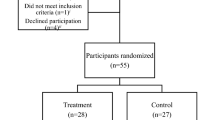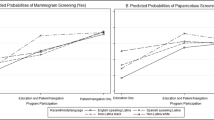Abstract
Purpose
Papanicolaou (Pap) testing has dramatically decreased cervical cancer incidence in the USA, but only 83 % of women screen according to guidelines. Our study aimed to examine the real-world effectiveness of various outreach methods in engaging patients who are overdue for cervical cancer screening.
Methods
In total, 1,100 patients at an urban federally qualified health center overdue for Pap testing were randomized to receive usual care (control), letter outreach, email outreach, telephone outreach, or multimodal (letter/email/telephone) outreach over a period of 3 months. Eighteen months after randomization, medical records were used to determine whether and when each patient had obtained a Pap.
Results
Compared to patients receiving usual care, patients in the multimodal (36 vs. 21 %, AOR 2.3, 95 % CI 1.4, 3.6) and telephone (29 vs. 21 %, AOR 1.7, 95 % CI 1.1, 2.8) outreach groups were significantly more likely to receive cervical cancer screening during the follow-up period. Intervention effects were similar among older and younger patients. Telephone, multimodal, and letter outreach resulted in significantly lower median time to screening among patients who did screen (119, 122, and 157 days, respectively) in those groups as compared to the usual care group (270 days).
Conclusions
This is the first study to perform a direct, randomized comparison of four distinct cervical cancer outreach intervention modalities with a control usual care group, ensuring comparability across intervention methods. In an urban primary care setting, a multimodal outreach strategy was most effective at increasing the proportion of overdue patients who undergo cervical screening and decreasing time to screening.
Clinical Trials Registry
ClinicalTrials.gov; Registration Number: NCT02427399; https://clinicaltrials.gov/ct2/show/NCT02427399.


Similar content being viewed by others
References
Schiffman M et al (1996) Cervical cancer. In: Schottenfeld D, Fraumeni JJ (eds) Cancer epidemiology and prevention. Oxford University Press, New York, pp 1090–1116
CDC (2012) Cancer screening-United States, 2010. MMWR Morb Mortal Wkly Rep 61:41–45
Peitzmeier SM et al (2014) Pap test use is lower among female-to-male patients than non-transgender women. Am J Prev Med 47(6):808–812
Freeman HP, Wingrove BK (2005) Excess cervical cancer mortality: a marker for low access to health care in poor communities. National Cancer Institute, Center to Reduce Cancer Health Disparities. NIH Pub. No. 05–5282
Agenor M et al (2014) At the intersection of sexual orientation, race/ethnicity, and cervical cancer screening: assessing Pap test use disparities by sex of sexual partners among black, Latina, and white U.S. women. Soc Sci Med 116:110–118
Glasgow RE et al (2000) Barriers to mammography and Pap smear screening among women who recently had neither, one or both types of screening. Ann Behav Med 22(3):223–228
Pasick RJ, Hiatt RA, Paskett ED (2004) Lessons learned from community-based cancer screening intervention research. Cancer 101(5 Suppl):1146–1164
Everett T et al (2011) Interventions targeted at women to encourage the uptake of cervical screening. Cochrane Database Syst Rev 5:CD002834
Vogt TM et al (2003) The safety net: a cost-effective approach to improving breast and cervical cancer screening. J Womens Health (Larchmt) 12(8):789–798
Valanis B et al (2003) Screening rarely screened women: time-to-service and 24-month outcomes of tailored interventions. Prev Med 37(5):442–450
Rashid RM et al (2014) Cost effective analysis of recall methods for cervical cancer screening in Selangor—results from a prospective randomized controlled trial. Asian Pac J Cancer Prev 15(13):5143–5147
Muller D et al (2009) The effectiveness of a secure email reminder system for colorectal cancer screening. AMIA Annu Symp Proc 2009:457–461
Chaudhry R et al (2007) Web-based proactive system to improve breast cancer screening: a randomized controlled trial. Arch Intern Med 167(6):606–611
Oscarsson MG et al (2007) Promotion of cervical screening among nonattendees: a partial cost-effectiveness analysis. Eur J Cancer Prev 16(6):559–563
Rimer BK et al (1999) The impact of tailored interventions on a community health center population. Patient Educ Couns 37(2):125–140
Fang CY et al (2007) A multifaceted intervention to increase cervical cancer screening among underserved Korean women. Cancer Epidemiol Biomark Prev 16(6):1298–1302
Lasser KE et al (2009) A multilevel intervention to promote colorectal cancer screening among community health center patients: results of a pilot study. BMC Fam Pract 10:37
Percac-Lima S et al (2009) A culturally tailored navigator program for colorectal cancer screening in a community health center: a randomized, controlled trial. J Gen Intern Med 24(2):211–217
Hendren S et al (2014) Randomized, controlled trial of a multimodal intervention to improve cancer screening rates in a safety-net primary care practice. J Gen Intern Med 29(1):41–49
Fiscella K et al (2010) Get screened: a pragmatic randomized controlled trial to increase mammography and colorectal cancer screening in a large, safety net practice. BMC Health Serv Res 10:280
Fortuna RJ et al (2014) Get screened: a randomized trial of the incremental benefits of reminders, recall, and outreach on cancer screening. J Gen Intern Med 29(1):90–97
Fontaine PL, Saslow D, King VJ (2012) ACS/ASCCP/ASCP guidelines for the early detection of cervical cancer. Am Fam Physician 86(6):501 (506–507)
McDowell I, Newell C, Rosser W (1989) Computerized reminders to encourage cervical screening in family practice. J Fam Pract 28(4):420–424
Binstock MA et al (1997) Pap smear outreach: a randomized controlled trial in an HMO. Am J Prev Med 13(6):425–426
Mayer KH et al (2007) Fenway Community Health’s model of integrated community based LGBT care, education and research. In: Meyer IH, Northridge ME (eds) The health of sexual minorities. Springer, New York, pp 693–715
Makadon HJ et al (2007) The Fenway guide to enhancing lesbian, gay, bisexual, and transgender healthcare. Philadelphia American College of Physicians, Philadelphia
Peitzmeier SM (2013) Promoting cervical cancer screening among lesbians and bisexual women. http://fenwayhealth.org/documents/the-fenway-institute/policy-briefs/PolicyFocus_cervicalcancer_web.pdf
Saslow D et al (2012) American Cancer Society, American Society for Colposcopy and Cervical Pathology, and American Society for Clinical Pathology screening guidelines for the prevention and early detection of cervical cancer. CA Cancer J Clin 62(3):147–172
Committee on Practice, B-G (2012) ACOG Practice Bulletin Number 131: screening for cervical cancer. Obstet Gynecol 120(5):1222–1238
Chow S-C, Wang H, Shao J (2007) Sample size calculations in clinical research. CRC Press, Boca Raton
Kahan BC et al (2014) The risks and rewards of covariate adjustment in randomized trials: an assessment of 12 outcomes from 8 studies. Trials 15:139
Fishman P et al (2000) Cost-effectiveness of strategies to enhance mammography use. Eff Clin Pract 3(5):213–220
Leong SL et al (2005) Enhancing doctor–patient communication using email: a pilot study. J Am Board Fam Pract 18(3):180–188
Moyer CA et al (2002) Bridging the electronic divide: patient and provider perspectives on e-mail communication in primary care. Am J Manag Care 8(5):427–433
Gurol-Urganci I et al (2013) Mobile phone messaging reminders for attendance at healthcare appointments. Cochrane Database Syst Rev 12:CD007458
World Health Organization (2013) WHO guidelines for screening and treatment of precancerous lesions for cervical cancer prevention. WHO, Geneva
Eaker S et al (2004) A large population-based randomized controlled trial to increase attendance at screening for cervical cancer. Cancer Epidemiol Biomark Prev 13(3):346–354
Snell JL, Buck EL (1996) Increasing cancer screening: a meta-analysis. Prev Med 25(6):702–707
Benard VB et al (2015) The effectiveness of targeting never or rarely screened women in a national cervical cancer screening program for underserved women. Cancer Causes Control 26(5):713–719
Howard M, Agarwal G, Lytwyn A (2009) Accuracy of self-reports of Pap and mammography screening compared to medical record: a meta-analysis. Cancer Causes Control 20(1):1–13
Service NH (2015) Cervical screening—when it’s offered [cited 2016 June 29]. http://www.nhs.uk/Conditions/Cervical-screening-test/Pages/When-should-it-be-done.aspx
Nguyen TT et al (2006) Papanicolaou testing among Vietnamese Americans: results of a multifaceted intervention. Am J Prev Med 31(1):1–9
Acknowledgments
This work was funded through the HRSA Bureau of Primary Health Care Supplemental 330 Community Health Center Contract (H80CS00303) provided by the Health Resources and Services Administration at the US Department of Health and Human Services.
Conflict of interest
There are no conflicts of interest to declare.
Author information
Authors and Affiliations
Corresponding author
Rights and permissions
About this article
Cite this article
Peitzmeier, S.M., Khullar, K. & Potter, J. Effectiveness of four outreach modalities to patients overdue for cervical cancer screening in the primary care setting: a randomized trial. Cancer Causes Control 27, 1081–1091 (2016). https://doi.org/10.1007/s10552-016-0786-6
Received:
Accepted:
Published:
Issue Date:
DOI: https://doi.org/10.1007/s10552-016-0786-6




